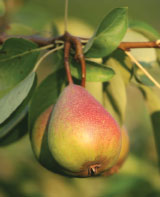
Features
Fruit
Production
Computer model explains pear browning during storage
April 23, 2008 By Fruit & Vegetable
Internal browning of pears stored
under low oxygen conditions is related to restricted gas exchange
inside the fruit, according to a new study recently published in the
open-access journal Public Library of Science (PLoS) Computational
Biology.
 Internal browning of pears stored under low oxygen conditions is related to restricted gas exchange inside the fruit, according to a new study recently published in the open-access journal Public Library of Science (PLoS) Computational Biology.
Internal browning of pears stored under low oxygen conditions is related to restricted gas exchange inside the fruit, according to a new study recently published in the open-access journal Public Library of Science (PLoS) Computational Biology.
Researchers at the Catholic University of Leuven in Belgium suggest a com-puter model can be used to improve long-term storage of fruit under controlled atmospheres.
Pears and other fleshy fruit are commercially stored under low oxygen conditions to extend their storage life for up to nine months. If the oxygen concentration in the storage atmosphere is too low, quality disorders such as internal browning may result, causing major economic losses. This disorder is related to the complex mechanisms of gas exchange, respiration and fermentation in fruit. However, further conclusions are unavailable due to the lack of reliable methods to measure gas concentrations inside the fruit.
The team, led by Bart Nicolä, has developed a comprehensive computer model to predict the oxygen concentration inside the pear. The model incorporates equations for gas transport as well as for the respiratory metabolism. The researchers found that extremely low oxygen concentrations can occur in the core of the pear, which may eventually lead to cell death and browning.
While the model was developed for pears, the model is generic. Application to other fleshy fruit and plant organs is straightforward, but the tissue properties and the geometry will need to be measured, Nicolä says. Further advances require investigation of the internal microstructure of the tissue to explain differences in gas exchange properties and to quantify the cellular and intercellular pathways for gas exchange and the metabolic processes.
The full report can be viewed at http://www.ploscompbiol.org/doi/pcbi.1000023 .
Print this page